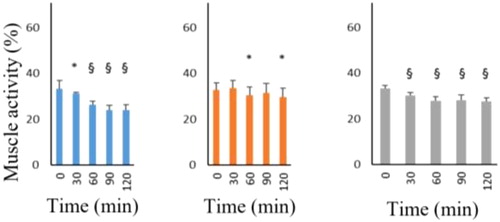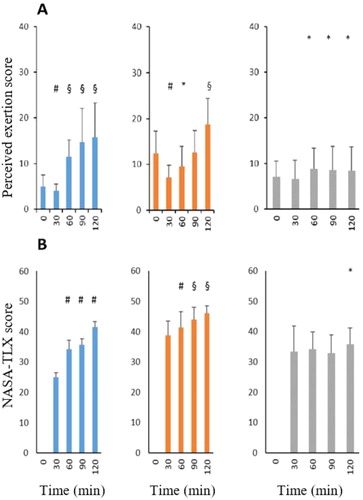1. Introduction
Physical inactivity is a major public health problem, and a lot of works, such as office work involving static and prolonged sitting posture, highly contribute to it (Commissaris et al. Citation2016). Moreover, such prolonged postures also increase the risk for musculoskeletal disorders. In this context, several adaptations in workstations have been studied, such as standing, sitstand, active, or dynamic workstations (Cao et al. Citation2016), to increase physical activity or decrease sedentary behavior while maintaining working performance. Currently, no workstation has been found to increase energy expenditure and comfort while maintaining work efficiency simultaneously, hence demanding to explore other solutions to limit physical inactivity at work.
This preliminary study aimed at comparing muscle activity and perceived exertion when working for two hours in standing, standing on balance board and innovative postures. The hypothesis was a similar muscle activity in the three postures, and a decreased perceived fatigue and load with innovative postures.
2. Methods
2.1. Participants
Three healthy males and two females (Age: 31.0 ± 9.7 years, Height: 168.6 ± 5.3 cm, Mass: 66.8 ± 4.1 kg) volunteered to participate in this study and signed an informed consent.
2.2. Procedure and data collection
The participants performed three sessions one week apart at the same time of the day. The difference between the three sessions was only the body support at workstation, i.e., working in a standing posture, working while standing on a balance board (FluidStance®), and working with an innovative “standing chair” (Faouen and Rubinstein Citation2018), assigned randomly. The innovative standing chair (Faouen and Rubinstein Citation2018) has front and back supports in order to allow the worker to choose from forward- to backwardleaning postures at his/her convenience. For each session, the following procedure was designed. After shaving and cleaning the skin of the participants, eight electromyography (EMG) surface electrodes (Trigno, Delsys Inc., Boston, MA) were stuck with regards to the muscle belly of the left and right erector spinae, external oblique, biceps femoris and soleus in line with SENIAM recommendations (Hermens et al. Citation2000). In order to normalize EMG signals, the participants were asked to walk at a preferred speed alongside a 15-m straight line.
Thereafter, the test session consisted in performing 2 hours of office tasks. Immediately before, every thirty minutes and immediately after the working session, muscle activities were recorded, while the participant stood in the anatomical position for one minute. In addition, the participants filled two questionnaires assessing the perceived exertion (Thorp et al. Citation2014) and the task load (NASA-TLX; Hart and Staviland Citation1988).
Raw EMG signal were normalized with respect to the mean activity measured for each muscle during the walking task Ghazwan et al. (Citation2017). The dependant variables kept for analysis were the mean total muscle activity corresponding to the mean of each normalized muscle activity, the perceived exertion score and the NASA-TLX score.
2.3. Statistics
Given the small number of participants, no inferential statistics have been performed. For each dependant variable mentioned above, the Cohen’s effect size (ES) was computed to assess the change in the dependant variable between an instant Tx and its initial value (just before the beginning of the task). A strong effect was associated to an absolute value of the effect size superior to 0.80, while medium effect corresponded to an effect size between 0.50 and 0.79, a small effect to values between 0.20 and 0.49.
3. Results and discussion
Total muscle activity decreased strongly (ES >0.8) from 60 min and from 30 min for the standing and “standing chair” conditions, respectively, in comparison with the beginning of the task (). These results suggested that a fatigue of the erector spinae, external oblique, biceps femoris and soleus muscles may be counterbalanced by other muscles to maintain these standing postures during the tests. By contrast, muscle activity remained stable for the balanced board condition ().
Figure 1. Mean normalized total muscle activity for the standing upright (left), balance board (middle) and “standing chair” (right) with respect to the time. * for effect size ≥ 0.20 and § for effect size ≥ 0.8.

The perceived exertion was strongly (ES > 0.80) and moderately (ES > 0.5) increased from 60 min and 120 min with the standing and balance board conditions, respectively (). By contrast perceived exertion was slightly (ES > 0.20) increased with the “standing chair” in comparison with the beginning of the task (). Task load was moderately (ES > 0.50) and strongly (ES > 0.80) increased from 30 min with the standing and balance board conditions respectively, while it remained unchanged with the “standing chair” (). These results tend to confirm those observed in the literature about standing workstation, namely an increase of energy expenditure (Cao et al. Citation2016).
4. Conclusions
The “standing chair” led to changes in muscle activity in the same way as the standing condition, which may be explained by a similar physical effort between the two conditions. Nevertheless, perceived exertion and task load were not increased after two hours of office work with the “standing chair” meaning that the latter may be advised in order to increase energy expenditure without affecting perceived exertion. Future works are needed to assess the real energy expenditure in such conditions and to identify pose strategies used by workers on the “standing chair”.
Acknowledgements
Financial grant from “Cité du Design”, the French design promotion center.
References
- Cao C, Liu Y, Zhu W, Ma J. 2016. Effect of active workstation on energy expenditure and job performance: a systematic review and metaanalysis. J Phys Act Health. 13(5):562–571.
- Commissaris D.A, Huysmans M.A, Mathiassen S.E, Srinivasan D, Koppes L.L, Hendriksen I.J. 2016. Interventions to reduce sedentary behavior and increase physical activity during productive work: a systematic review. Scand J Work Environ Health. 42(3):181–191.
- Faouen P, Rubinstein L. 2018. Anterior support device for the lower limbs. WO 2018/104595
- Ghazwan A, Forrest SM, Holt CA, Whatling GM. 2017. Can activities of daily living contribute to EMG normalization for gait analysis? PLoS One. 12(4):e0174670.
- Hart S.G, Staviland L.E. 1988. Development of NASA-TLX (Task Load Index). Results of empirical and theoretical research. Adv Psychol. 52:139–183.
- Hermens H.J, Freriks B, Disselhorst-Klug C, Rau G. 2000. Development of recommendations for semg sensors and sensor placement procedures. J Electromyogr Kinesiol. 10(5):361–374.
- Thorp A.A, Kingwell B.A, Owen N, Dunstan D.W. 2014. Breaking up workplace sitting time with intermittent standing bouts improves fatigue and musculoskeletal discomfort in overweight/obese office workers. Occup Environ Med. 71(11):765–771.

